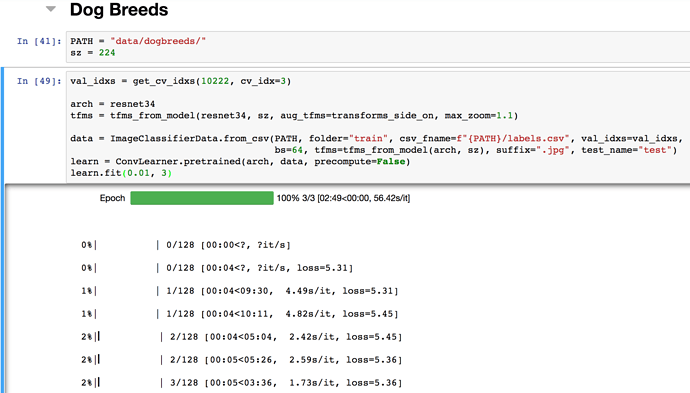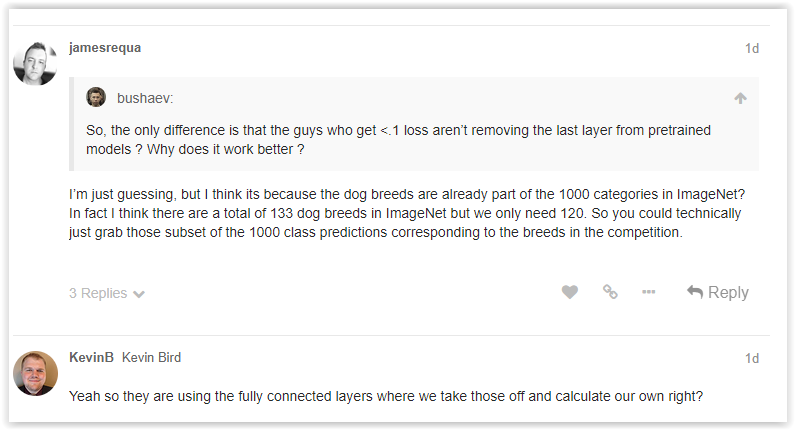Thanks @KevinB will report it.
yeah works fine now after that fix Thanks @rob
Can someone help me with this error. I’m not able to find any post related to this. I’m trying to replicate the dogbreed notebook. I’m trying to run this on AWS p2 instance.
Get rid of that line I believe is what Jeremy told somebody else. Other thing you could try is setting it to 0 but I think that’s the default.
Thanks I just saw it in the beginner forum
Oh apologies I didn’t realize that it’s not in 0.2. I’ll revert.
That just means you need to restart your kernel. It’s a bug in tqdm, or probably actually in the jupyter console code.
Damn! Works like a charm now 
That was quick! It works fine now 
Trying to understand if this conversation is about how to train with the entire data and all of the intelligence of the resnext model - what is meant by not “removing the last layer from pretrianed models” and " they are using the fully connected layers where we take those off and calculate our own"?
How can I do what is being talked about here - what is it that we do that removes the last layer, what can we do that preserves it?
Also, how can we retain all of the data to train with?
If you just want to remove the last layer you may need to do a little bit of extra work. One possibility is what I did here.
https://github.com/yanneta/pytorch-tutorials/blob/master/modified_VGG.ipynb
This could be simplified with the new API that Jeremy just wrote. See an example here.
https://github.com/fastai/fastai/blob/master/courses/dl1/cifar10.ipynb
I am happy to help if you have any questions. My example work for vgg16 you would have to understand the network that you are trying to change.
I’ve got an example of how to cut layers off custom models that I’ll be pushing soon-ish. We’ll be discussing it later in the course.
OK this is at the more advanced end for now - but for those interested in understanding fastai more deeply:
I just added nasnet.ipynb . It shows how to use a new pretrained model type that’s not already in fastai. (This particularly one is really slow BTW, although it should be better with 0.3).
Note that I also changed fastai.models.nasnet to optionally skip that classifier section.
wow nasnet, thats awesome…Thanks @jeremy !
For anyone interested in learning more about it…
Actually I am quite confused about what is being discussed here.
What I was asking here was for someone to explain exactly what were these guys getting at when they said that the (I presumed standard) approach is “removing the last layer from pretrianed models” - because the guys that are NOT doing that are getting better results. I was not asking how to remove the last layer - but how to understand what the contributors @bushaev, @jamesrequa and @KevinB meant that we should NOT be removing it, and that they (the better scoring people) are “using the fully connected layers where we take those off and calculate our own”. Do they mean that we shouldn’t set precompute to false? It didn’t make sense to me…
I was asking for clarification, but if I understand it correctly, they are doing well because the data is literally being trained on the same images that are in the test set. So this would be comparable to training using our validation set. It would give us a very good score, but it doesn’t really help in any real-world scenario. They are basically exploiting the fact that they know what data the set comes from and choosing a model that starts with that and keeping those activations. I was and still am asking for clarification on whether I actually understand why they are doing so well, but that is what I was asking in my post.
I have tried this, and val_idxs = 0, and also val_idxs = get_cv_idxs(n, val_pct=0.01), but I continue to get an error (below). Does anyone know how to do this reliably?
Should we have one image per class in our validation set?
---------------------------------------------------------------------------
AssertionError Traceback (most recent call last)
<ipython-input-24-0708a7145fb8> in <module>()
----> 1 learn = ConvLearner.pretrained(arch, data, precompute=True, ps=0.5)
~/fastai/courses/dl1/fastai/conv_learner.py in pretrained(cls, f, data, ps, xtra_fc, xtra_cut, **kwargs)
92 def pretrained(cls, f, data, ps=None, xtra_fc=None, xtra_cut=0, **kwargs):
93 models = ConvnetBuilder(f, data.c, data.is_multi, data.is_reg, ps=ps, xtra_fc=xtra_fc, xtra_cut=xtra_cut)
---> 94 return cls(data, models, **kwargs)
95
96 @property
~/fastai/courses/dl1/fastai/conv_learner.py in __init__(self, data, models, precompute, **kwargs)
85 elif self.metrics is None:
86 self.metrics = [accuracy_multi] if self.data.is_multi else [accuracy]
---> 87 if precompute: self.save_fc1()
88 self.freeze()
89 self.precompute = precompute
~/fastai/courses/dl1/fastai/conv_learner.py in save_fc1(self)
132 self.fc_data = ImageClassifierData.from_arrays(self.data.path,
133 (act, self.data.trn_y), (val_act, self.data.val_y), self.data.bs, classes=self.data.classes,
--> 134 test = test_act if self.data.test_dl else None, num_workers=8)
135
136 def freeze(self):
~/fastai/courses/dl1/fastai/dataset.py in from_arrays(cls, path, trn, val, bs, tfms, classes, num_workers, test)
296 ImageClassifierData
297 """
--> 298 datasets = cls.get_ds(ArraysIndexDataset, trn, val, tfms, test=test)
299 return cls(path, datasets, bs, num_workers, classes=classes)
300
~/fastai/courses/dl1/fastai/dataset.py in get_ds(fn, trn, val, tfms, test, **kwargs)
264 def get_ds(fn, trn, val, tfms, test=None, **kwargs):
265 res = [
--> 266 fn(trn[0], trn[1], tfms[0], **kwargs), # train
267 fn(val[0], val[1], tfms[1], **kwargs), # val
268 fn(trn[0], trn[1], tfms[1], **kwargs), # fix
~/fastai/courses/dl1/fastai/dataset.py in __init__(self, x, y, transform)
160 def __init__(self, x, y, transform):
161 self.x,self.y=x,y
--> 162 assert(len(x)==len(y))
163 super().__init__(transform)
164 def get_x(self, i): return self.x[i]
AssertionError:
Can you post your data variable generation too?
PATH = "data/dogbreed/"
arch=resnext101_64
sz=224
bs=64
tfms = tfms_from_model(arch, sz, aug_tfms=transforms_side_on, max_zoom=1.1)
data = ImageClassifierData.from_csv(PATH, ‘train’, f’{PATH}labels.csv’, bs=bs, tfms=tfms,
val_idxs=val_idxs, suffix = ‘.jpg’, test_name = ‘test’,
num_workers=4)


